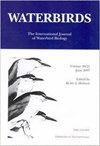圈养美洲白鹈鹕自然感染西尼罗病毒。
IF 0.6
4区 生物学
Q3 ORNITHOLOGY
引用次数: 1
摘要
摘要在密西西比州斯塔克维尔的27只圈养美国白鹈鹕中,有23只发生了西尼罗病毒推定的自然暴发。21只鸡通过逆转录酶PCR、免疫组化(IHC)或补体固定血清学检测证实呈阳性。另外两只鸟由于通常归因于西尼罗病毒的组织学变化而推定呈阳性。在23只受感染的鹈鹕中,有两只之前被植入了温度监测器,并作为案例研究。这些鸟在7月放置后的第27天和第30天开始出现临床症状,在这两种情况下,在前一天食物摄入量减少。在这两只鸟中观察到的最初临床症状包括翅膀下垂和嗜睡,在72小时内,这两只鸟在喂食过程中表现出增加的躁动和攻击性。在这里,我们详细介绍了由西尼罗病毒引起的两例疾病的进展。本文章由计算机程序翻译,如有差异,请以英文原文为准。
Natural West Nile Virus Infections in Captive Raised American White Pelicans (Pelecanus erythrorhynchos).
Abstract. A presumptive natural West Nile virus outbreak occurred in 23 of 27 captive American White Pelicans (Pelecanus erythrorhynchos) located in Starkville, Mississippi. Twenty-one birds were confirmed positive through either reverse transcriptase PCR, immunohistochemistry (IHC) or complement fixation serological testing. Two additional birds were presumed positive by histological changes typically ascribed to West Nile virus. Two of the 23 infected pelicans had been previously implanted with a temperature monitor and served as case studies. These birds began showing clinical signs in July on day 27 and 30 post-placement, preceded by a reduction in food intake one day prior in both cases. Initial clinical signs observed in both birds included wing droop and lethargy and within 72 hours both birds displayed increased agitation and aggression during feeding. Here we detail the progression of disease caused by West Nile virus in two cases.
求助全文
通过发布文献求助,成功后即可免费获取论文全文。
去求助
来源期刊

Waterbirds
生物-鸟类学
CiteScore
1.30
自引率
0.00%
发文量
0
审稿时长
6-12 weeks
期刊介绍:
Waterbirds is an international scientific journal of the Waterbird Society. The journal is published four times a year (March, June, September and December) and specializes in the biology, abundance, ecology, management and conservation of all waterbird species living in marine, estuarine and freshwater habitats. Waterbirds welcomes submission of scientific articles and notes containing the results of original studies worldwide, unsolicited critical commentary and reviews of appropriate topics.
 求助内容:
求助内容: 应助结果提醒方式:
应助结果提醒方式:


